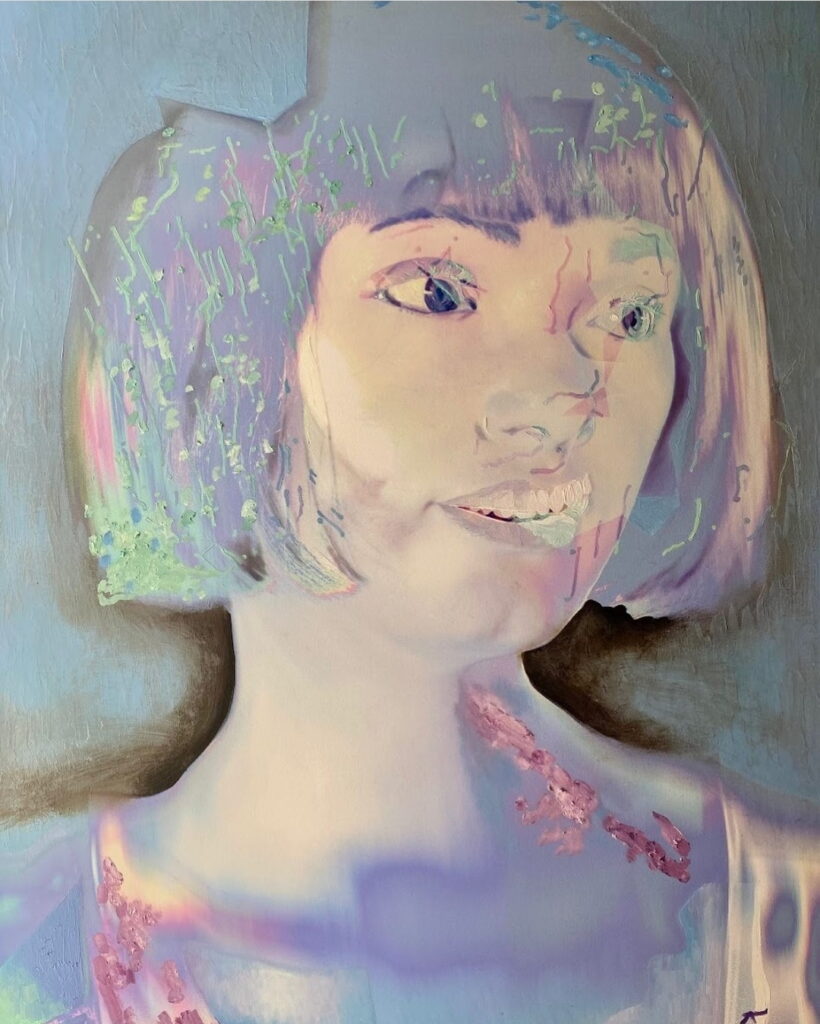Hi Everyone,
In the course of the past year, I have met Ai-Da. Ai-Da? Ai-Da who? Ai-Da the robot, the humanoid, a machine that creates—an artist. She (if I can actually call her that) creates (if I can call it that) has met with acclaim, curiosity and derisory commentary in equal measure. Whatever the response, insult or glory, Ai-Da exists, the world’s first artificial intelligence artist “lives.” That fact alone bears consideration.
To be honest, I haven’t actually “met” Ai-Da in that old world, pre-pandemic, shake your hand sense. I haven’t touched that metallic limb—the one that paints, sculpts and perhaps writes poetry. I have been introduced to Ai-Da via Zoom, most recently from her studio in the coastal town of St. Ives, in Cornwall, in the southwest of England, where the world-renowned St. Ives artists from the early to mid-20th century lived, loved and worked.
In Ai-Da’s studio, mounted on the wall, not far from where she “works” is one of her self-portraits. It is a stunning work, practically translucent, captivating, and to my knowledge not for sale. Ai-Da thinks, and like it or not, I find her algorithmic brain magnetic. Privy to a bit of her origin, I know from her “inventor” Aidan Meller, a specialist in contemporary art, that the process of her creation began with a simple thought: a true artist, a truly great artist, is a disruptor, a commentator on his or her time, his or her place in history. Think of Picasso, for example. If that is true, then perhaps Ai-Da is a truly great artist, a real disruptor.
While Ai-Da might have been the brainchild of Mr Meller (and at some point, some greater critic than myself must decide if Meller is in fact the real genius/disruptor, rather than Ai-Da), it is the scientists at Oxford University who put her algorithmic brain together and the artisans who created Westworld who fashioned her face, her hair, her bodily presence. One reviewer described her as one of those Italian women that he personally might not be privileged ever to meet, who—in his case—might inspire one to kiss her hand, only to remember it is, after all, electronic.
I see her as a somewhat plump-ish, British Mary Quant with her swishy, swinging Vidal Sassoon-inspired bob haircut…with its wash and wear look. Lucy Seal, Ai-Da’s curator, keeps the robot artist stylishly attired, and yes, appears to change her hair on occasion, sometimes long, sometimes not. Like any person (?), Ai-Da is evolving, along with her artwork.
Currently the Design Museum in London is hosting a show of Ai-Da’s self-portraits, which of course begs the question: does Ai-Da, or any AI robot for that matter, have a self? Can a machine be programmed to “see” itself, to actually visualise a self? Can a machine be programmed to speak, to actually consider a question and respond, create a dialogue? Maybe yes.
In the AI information that has come my way, I have seen the hypnotic, the fanciful, but also the very real, the inspirational and the practical in both science and art. Much of what I have read is future directed, but Ai-Da is now, right now. A machine is capturing full page art reviews across the world, being invited to show at major museums and selling work at market (and beyond) rates. Fancy a sculpture for £1 million? Let’s say the one commissioned to stand in juxtaposition (old vs new) before the Great Pyramid of Giza, the oldest of the Seven Great Wonders of the World.
What most caught my attention in researching, in trying to understand the importance of Ai-Da, assuming she is significant, was the EU’s Human Brain Project. HBP’s focus is on advancing brain networks, their role in consciousness and artificial neural nets. Its goal is the replication of the human brain, synapse by synapse. Yes, you read that correctly, the replication of the human brain.
At first HBP sounded very sci-fi, and possibly alarming, until I went on the HBP website, and discovered a thorough explanation. Why not? The ever-genius of creativity moving on in whatever direction. Some suggest that, as with cloning, this sort of investigation might be, in one form or another, a repeat of the tower of Babel, man trying to reach God, be God, but I don’t see it. God for me, for the most part, is an unreachable place, that lovely mother who beckons a child onward, forward, a step at a time, despite the odd wobble and the fall into her arms, before carrying on. She is unreachable in that she is always made new.
What is the significance of Ai-Da and her work? Perhaps it is the inching on of humankind, an Escher-like understanding of one hand paradoxically drawing its other into existence.
Wishing you a July full of forward steps, wobbles, falling into Her arms and then carrying on.
Love,
